
1. Young women embroidering a wedding ludi (veil) for their future sister-in-law, in Bhopa ni Vandh, c.1998
Traditionally Rabari women skillfully hand embroidered garments, household decorations and animal trappings to beautify their lives. Embroidery was a way to contribute to the dowry women had to bring to their in-laws’ homes, an important expression of a woman’s capability and creativity, and an avenue for in-person social networking.
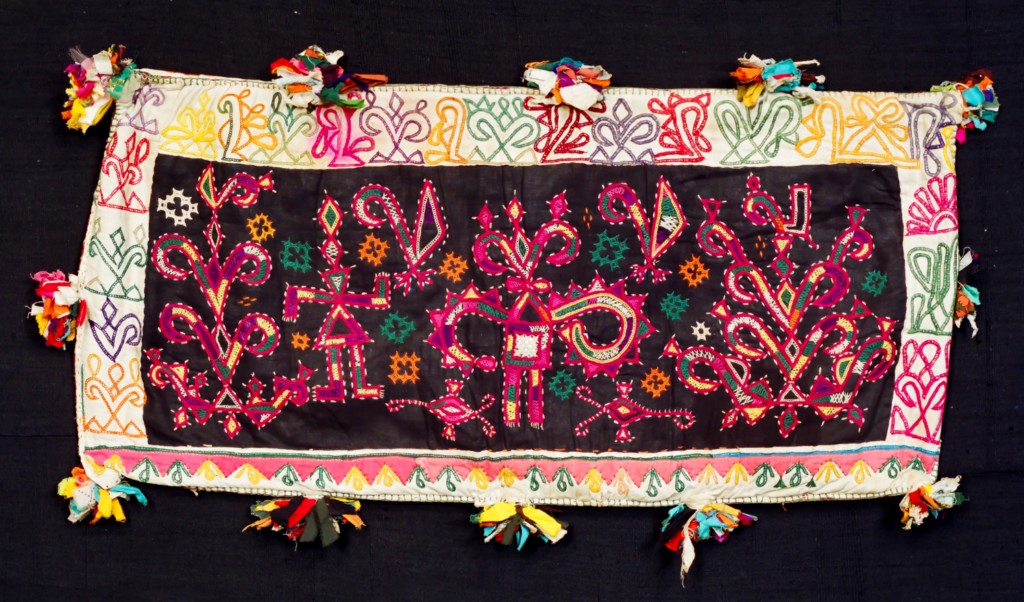
2. Kachhi Rabari oshiku (pillow cover) c. 1960 The tableau, depicting left to right a tree with a peacock on top, a woman carrying water pots, a peacock, a scorpion, an elephant with rider, and again peacock, scorpion and tree, evokes a Rabari wedding.
Women embroidered with a style combining stitches, colours, patterns and motifs that were specific to their community. The patterns depicted their lives and were a woman’s non-literate language of expression. This cultural heritage quickly identified Rabaris to each other and to other communities. Rabari style slowly evolved over time as the community migrated to new regions and interacted with other communities. In evolution, Rabaris always maintained their identity while adapting to cultures of new regions. I learned about the history and expression of Rabari embroidery by studying in University libraries and museums. Later, living in India and working with Rabaris for five decades, I had the opportunity to observe how embroidery styles evolved to express Rabari life.
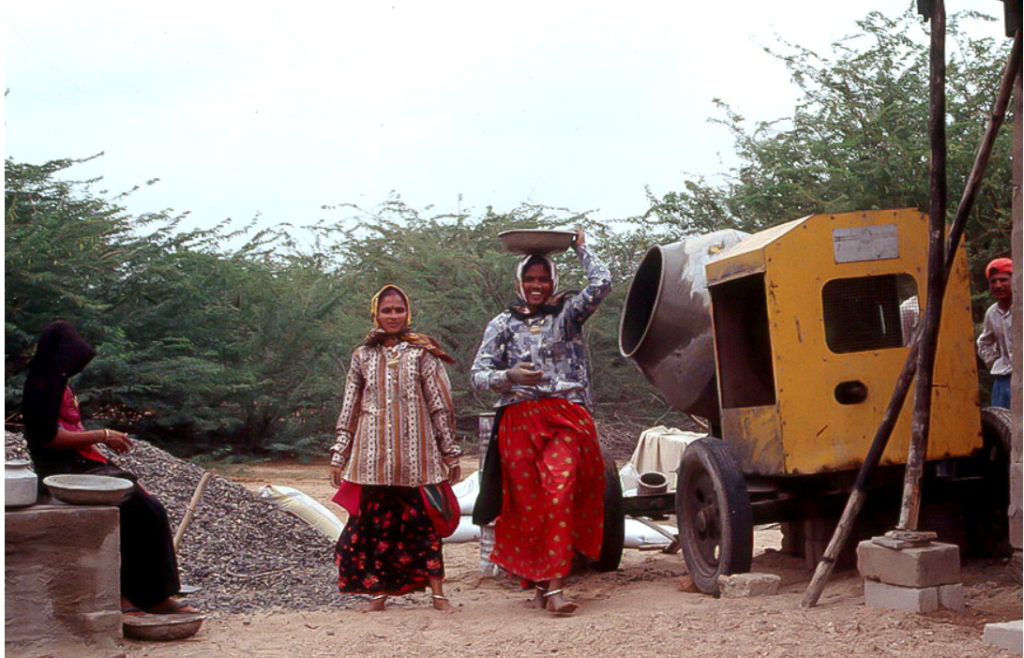
3. Rabari women doing construction work, Bhopa ni Vandh c. 2003
By the 1990s, inflation made life expensive and Rabari women had to earn money to supplement the family livelihood of selling milk, wool and animals. They began to embroider for merchants and designers for wages. Their community allowed them to work outside, so they also cleaned homes in cities, and did construction work. Commercial embroidery was equated with wage labour and usually women earned more in other jobs.
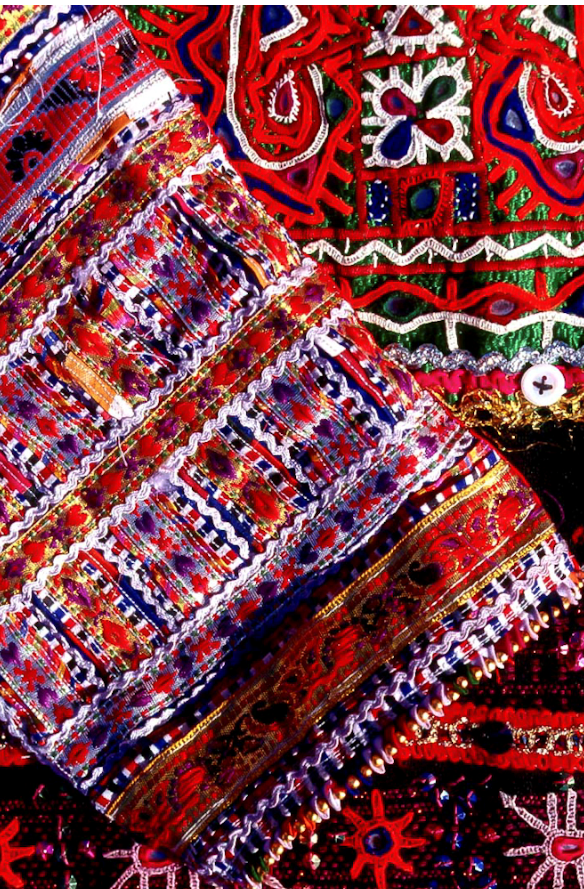
4. details of contemporary work of Dhebaria Rabaris (left) and Kachhi Rabaris, c. 2003
Women still wanted to wear beautiful clothes, and they still had to contribute to their dowries, but they had less time to embroider for themselves. In fact, because they were earning, they wanted to have even more embroidery than before. They found themselves in a dilemma. So, they used their creativity to invent ways to create elaborate work using less effort. Dhebaria Rabari leaders banned embroidery to address the time dilemma; but wearing embellishment was important to women, so they began to decorate their clothes with ribbons and trims stitched on by a sewing machine. Kachhi Rabari women solved their time dilemma by combining machine embroidery with hand work. Both groups used styles that resembled their hand embroidery so these were innovations in tradition that reflected and expressed changing circumstances.

5. Young Kachhi Rabari woman wearing ludi 2008
Commercial embroidery was done on patterns printed by clients. That also saved time. But for Rabari women embroidery was a way to be creative and express themselves, so for their own work they did not choose that option; they invented their own solutions in which they could continue to be creative.
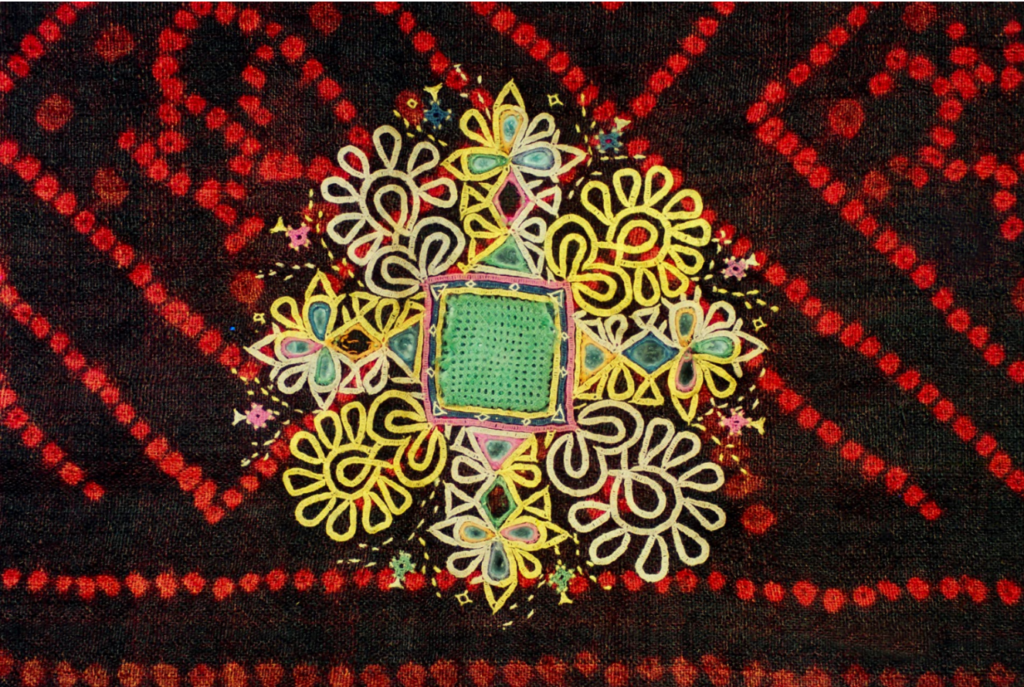
6. Kachhi Rabari ludaki (girls’ woollen veil) Bhujodi, c. 1970
You can see how the Kachhi embroidery style evolved but still retained its identity by looking at this motif on a girl’s woollen veil made about 1970.

7. Detail of Kachhi Rabari wedding ludi, Bhopani Vandh 2013
In 2013, 43 years later, Kachhi Rabari embroidery on a veil looked like this. The embroidery looks richer and more complex but is actually faster to stitch because it uses a lot of machine embroidery. And it still expresses Rabari identity. Rabari women were appropriately solving design problems.

8. Kachhi Rabari women at the opening of a temple, Bhopani Vandh 2011
Women understood how to use their shared traditions and still express their individual identity. Here, at a ceremony to open a new temple, you can see that all of the women seem to be wearing the same veil. But each one is also unique.
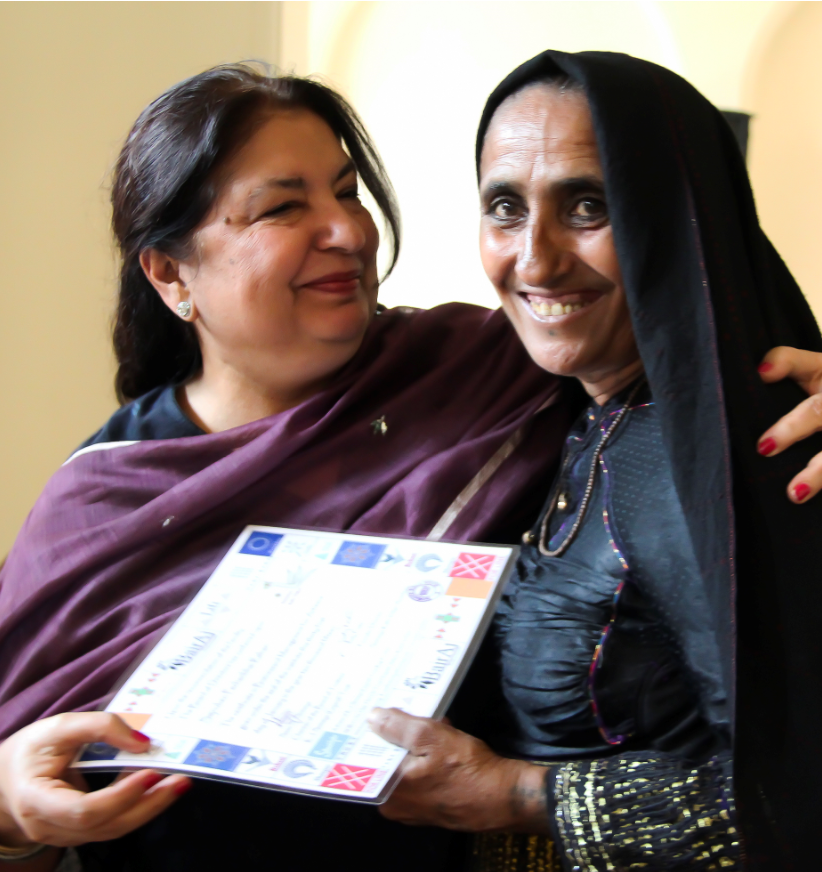
9. Sajnuben Pachan, a Dhebaria Rabari woman, receives her certificate for a year long post graduate course from Somaiya Kala Vidya in Business and Management for Artisans, 2014.
I understood that Rabari women were very creative and that design was important to them. But their embroidery was undervalued. Most of them had had very little opportunity to go to school and chronic undereducation hindered their ability to earn and to negotiate. So in 2005 I started a design school especially for traditional artisans. We taught in the local language and considered local culture. Artisans learned to use design to increase their value as creative artisans. I later added a post graduate course, Business and Management for Artisans.

10. Monghiben Rana, a Kachhi Rabari woman, walks the fashion show ramp with her collection at Good Earth Mumbai, 2013
Women who graduated from the courses became recognized for their creative designs, and for commercial work they earned much better wages than before.

11. A Kachhi Rabari wedding in Bhopani Vandh, 2019
Today, life is faster paced. Rabaris have a much wider exposure to the world through travel, mobile phones and TV. Like everyone, they want bigger, faster changes. The concept of fashion now drives the evolution of tradition. While some women continue to hand embroider to earn for their homes, embroidery has lost cultural relevance in their lives. Beauty, decoration and expressing cultural identity are as important as ever, especially for ceremonial occasions. But for themselves, Rabari women use ribbons, trims and machine embroidery more than hand embroidery. They use their creativity in this way, and the contemporary style expresses how Rabaris have adapted to today’s world.
This Photo Essay is brought to you in collaboration with Sthalantar Foundation. For more information on their work, visit Instagram or YouTube

Judy Frater
Judy Frater is a social entrepreneur steeped in the world of contemporary textile artisans of Kutch, India.
She lived in Kutch for 30 years, during which she co-founded and operated Kala Raksha Trust, a cooperative for women embroiderers, established the Kala Raksha Textile Museum, and founded Kala Raksha Vidhyalaya, the first design school for traditional artisans. For this concept, Ms. Frater was awarded an Ashoka Fellowship for social entrepreneurship in 2003. Under her eight- year tenure as Director of the school, Kala Raksha Vidhyalaya received international recognition for its unique approach to education of artisans. Frater received the Sir Misha Black Medal for Distinguished Services to Design Education in 2009, the Crafts Council of India Kamla award in 2010, the George B. Walter’36 Service to Society Award from Lawrence University in 2014 and the New Delhi Rotary Distinguished Service Award in 2020.
In 2014, to expand the design education program to an institute, Frater joined the K.J. Somaiya Gujarat Trust to begin Somaiya Kala Vidya. From 2014-2020, as Founder Director she initiated a graduate business and management course, Outreach to other regions, co-design programs, and a course in craft traditions for non-artisans.
Ms. Frater’s Threads of Identity: Embroidery and Adornment of the Nomadic Rabaris received the Costume Society of America’s Milla Davenport award. Prior to her residence in India, she was Associate Curator of the Eastern Hemisphere Collections at the Textile Museum, in Washington, DC.

